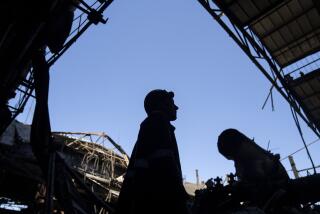Underground Explosion Kills 61 Coal Miners in Siberia
- Share via
MOSCOW — Sixty-one coal miners were killed in a huge underground explosion in Siberia on Tuesday, leaving Russia in mourning after one of the worst mining catastrophes in its history.
A methane blast, whose precise cause authorities pledged to investigate, ripped through the Zyryanovskaya coal mine in western Siberia at 1 a.m., after a new shift of workers had come down the shaft to start work but before the previous shift had left.
“There are about 100 rescue workers at the site,” said Col. Vasily Romanov, a Civil Defense chief in Siberia’s Kemerovo region. “Unfortunately, no one has yet been found alive.”
Five people were still missing as darkness fell Tuesday, Russia’s commercial television station NTV said.
Just six men made their way to the surface as Tuesday’s rescue operation continued. The evening newspaper Izvestia said they had all been hospitalized with burns and gas poisoning.
NTV showed one anxious though conscious miner, dark eyes thickly ringed with coal dust, lying in an iron lung. Other televised pictures showed miners’ shocked relatives and rescuers at the bleak pit, under a thin scattering of snow. Many were weeping. Some were carrying away corpses.
President Boris N. Yeltsin and Prime Minister Viktor S. Chernomyrdin, both abroad, sent condolences. “I mourn for the dead miners, and I worry about those injured and those who are still in the pit,” Yeltsin said from Sweden.
The faithful support of coal miners, a mainstay of the old Soviet economy, helped Yeltsin come to power in 1991. Miners loyal to Yeltsin, then an upstart challenging Soviet leader Mikhail S. Gorbachev, went on strike to protest the failure of the Soviet superpower’s leader to pay them, an action that hastened the Soviet Union’s demise six years ago.
But since then, miners in Siberia’s Kuzbass coal area and in other mining regions farther east and north have had little reason to thank the Russian president. Yeltsin has repeatedly paid their wages months late and ignored the increasingly desperate conditions of Russian mining communities.
The local city, Novokuznetsk, is a rough place of collapsing apartment blocks, brute concrete and closed factories. Unemployment and crime are high. The number of mining accident fatalities has risen over the past two years, from 121 in 1996 to 191 in the first 11 months of 1997, said Vladimir Rossikhin, main labor-safety inspector of the Russian Coal Miners’ Union.
But the mine at Zyryanovskaya, opened in 1946, was relatively well off before Tuesday’s disaster. NTV said workers there were regularly paid and had never joined any strikes.
Whether Tuesday’s accident was the worst in Russian mining history cannot be established because Soviet officials did not publish statistics on casualties in the mines for much of the 20th century. Ruben Badanov, deputy chairman of the Russian Coal Miners Union, compared it with the deaths in September 1996 of 24 Russian and Ukrainian miners in a pit on Norway’s Arctic island of Spitzbergen.
“I do not think it is the worst accident in Russian history. There have been many cases. But this one was a real tragedy. We have not seen anything like this for many years,” Badanov said.
More to Read
Sign up for Essential California
The most important California stories and recommendations in your inbox every morning.
You may occasionally receive promotional content from the Los Angeles Times.










